parking brake KIA SELTOS 2022 Features and Functions Guide
[x] Cancel search | Manufacturer: KIA, Model Year: 2022, Model line: SELTOS, Model: KIA SELTOS 2022Pages: 62, PDF Size: 3.75 MB
Page 4 of 62
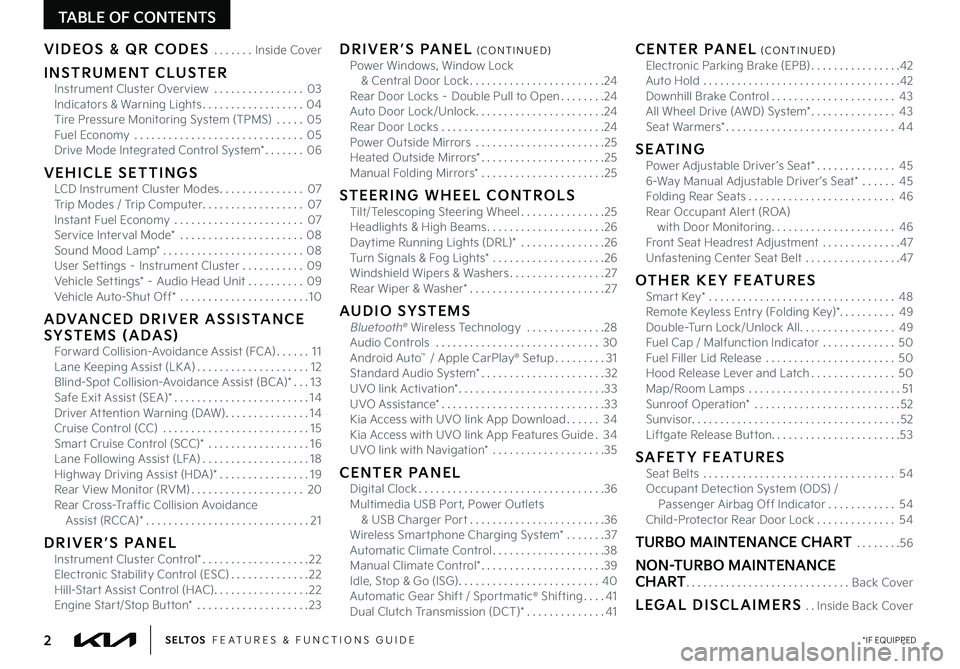
2*IF EQUIPPEDS E LT O S FEATURES & FUNCTIONS GUIDE
TABLE OF CONTENTS
VIDEOS & QR CODES . . . . . . .Inside Cover
INSTRUMENT CLUSTERInstrument Cluster Overview . . . . . . . . . . . . . . . .03Indicators & Warning Lights . . . . . . . . . . . . . . . . . .04Tire Pressure Monitoring System (TPMS) . . . . .05Fuel Economy . . . . . . . . . . . . . . . . . . . . . . . . . . . . . .05Drive Mode Integrated Control System* . . . . . . .06
VEHICLE SETTINGSLCD Instrument Cluster Modes . . . . . . . . . . . . . . .07Trip Modes / Trip Computer . . . . . . . . . . . . . . . . . .07Instant Fuel Economy . . . . . . . . . . . . . . . . . . . . . . .07Service Interval Mode* . . . . . . . . . . . . . . . . . . . . . .08Sound Mood Lamp* . . . . . . . . . . . . . . . . . . . . . . . . .08User Settings – Instrument Cluster . . . . . . . . . . .09Vehicle Settings* – Audio Head Unit . . . . . . . . . .09Vehicle Auto-Shut Off* . . . . . . . . . . . . . . . . . . . . . . .10
ADVANCED DRIVER ASSISTANCE SYSTEMS (ADAS)Forward Collision-Avoidance Assist (FCA) . . . . . .11Lane Keeping Assist (LK A) . . . . . . . . . . . . . . . . . . . .12Blind-Spot Collision-Avoidance Assist (BCA)* . . .13 Safe Exit Assist (SEA)* . . . . . . . . . . . . . . . . . . . . . . . .14Driver Attention Warning (DAW) . . . . . . . . . . . . . . .14Cruise Control (CC) . . . . . . . . . . . . . . . . . . . . . . . . . .15Smart Cruise Control (SCC)* . . . . . . . . . . . . . . . . . .16Lane Following Assist (LFA) . . . . . . . . . . . . . . . . . . .18Highway Driving Assist (HDA)* . . . . . . . . . . . . . . . .19Rear View Monitor (RVM) . . . . . . . . . . . . . . . . . . . .20Rear Cross-Traffic Collision Avoidance Assist (RCCA)* . . . . . . . . . . . . . . . . . . . . . . . . . . . . .21
DRIVER’S PANELInstrument Cluster Control* . . . . . . . . . . . . . . . . . . .22Electronic Stability Control (ESC) . . . . . . . . . . . . . .22Hill-Start Assist Control (HAC) . . . . . . . . . . . . . . . . .22Engine Start/Stop Button* . . . . . . . . . . . . . . . . . . . .23
DRIVER’S PANEL (CONTINUED)Power Windows, Window Lock & Central Door Lock . . . . . . . . . . . . . . . . . . . . . . . .24Rear Door Locks – Double Pull to Open . . . . . . . .24Auto Door Lock/Unlock . . . . . . . . . . . . . . . . . . . . . . .24Rear Door Locks . . . . . . . . . . . . . . . . . . . . . . . . . . . . .24Power Outside Mirrors . . . . . . . . . . . . . . . . . . . . . . .25Heated Outside Mirrors* . . . . . . . . . . . . . . . . . . . . . .25Manual Folding Mirrors* . . . . . . . . . . . . . . . . . . . . . .25
STEERING WHEEL CONTROLSTilt/Telescoping Steering Wheel . . . . . . . . . . . . . . .25Headlights & High Beams . . . . . . . . . . . . . . . . . . . . .26Daytime Running Lights (DRL)* . . . . . . . . . . . . . . .26Turn Signals & Fog Lights* . . . . . . . . . . . . . . . . . . . .26Windshield Wipers & Washers . . . . . . . . . . . . . . . . .27Rear Wiper & Washer* . . . . . . . . . . . . . . . . . . . . . . . .27
AUDIO SYSTEMSBluetooth® Wireless Technology . . . . . . . . . . . . . .28 Audio Controls . . . . . . . . . . . . . . . . . . . . . . . . . . . . .30 Android Auto™ / Apple CarPlay® Setup . . . . . . . . .31Standard Audio System* . . . . . . . . . . . . . . . . . . . . . .32UVO link Activation* . . . . . . . . . . . . . . . . . . . . . . . . . .33UVO Assistance* . . . . . . . . . . . . . . . . . . . . . . . . . . . . .33Kia Access with UVO link App Download . . . . . .34Kia Access with UVO link App Features Guide .34UVO link with Navigation* . . . . . . . . . . . . . . . . . . . .35
CENTER PANELDigital Clock . . . . . . . . . . . . . . . . . . . . . . . . . . . . . . . . .36Multimedia USB Port, Power Outlets & USB Charger Port . . . . . . . . . . . . . . . . . . . . . . . .36Wireless Smartphone Charging System* . . . . . . .37Automatic Climate Control . . . . . . . . . . . . . . . . . . . .38Manual Climate Control* . . . . . . . . . . . . . . . . . . . . . .39Idle, Stop & Go (ISG) . . . . . . . . . . . . . . . . . . . . . . . . .40Automatic Gear Shift / Sportmatic® Shifting . . . .41Dual Clutch Transmission (DCT)* . . . . . . . . . . . . . .41
CENTER PANEL (CONTINUED)Electronic Parking Brake (EPB) . . . . . . . . . . . . . . . .42Auto Hold . . . . . . . . . . . . . . . . . . . . . . . . . . . . . . . . . . .42Downhill Brake Control . . . . . . . . . . . . . . . . . . . . . .43All Wheel Drive (AWD) System* . . . . . . . . . . . . . . .43Seat Warmers* . . . . . . . . . . . . . . . . . . . . . . . . . . . . . .44
SEATINGPower Adjustable Driver ’s Seat* . . . . . . . . . . . . . .456-Way Manual Adjustable Driver ’s Seat* . . . . . .45Folding Rear Seats . . . . . . . . . . . . . . . . . . . . . . . . . .46Rear Occupant Alert (ROA) with Door Monitoring . . . . . . . . . . . . . . . . . . . . . .46Front Seat Headrest Adjustment . . . . . . . . . . . . . .47Unfastening Center Seat Belt . . . . . . . . . . . . . . . . .47
OTHER KEY FEATURESSmart Key* . . . . . . . . . . . . . . . . . . . . . . . . . . . . . . . . .48Remote Keyless Entry (Folding Key)* . . . . . . . . . .49Double-Turn Lock/Unlock All . . . . . . . . . . . . . . . . .49Fuel Cap / Malfunction Indicator . . . . . . . . . . . . .50Fuel Filler Lid Release . . . . . . . . . . . . . . . . . . . . . . .50Hood Release Lever and Latch . . . . . . . . . . . . . . .50Map/Room Lamps . . . . . . . . . . . . . . . . . . . . . . . . . . .51Sunroof Operation* . . . . . . . . . . . . . . . . . . . . . . . . . .52Sunvisor . . . . . . . . . . . . . . . . . . . . . . . . . . . . . . . . . . . . .52Liftgate Release Button . . . . . . . . . . . . . . . . . . . . . . .53
SAFETY FEATURESSeat Belts . . . . . . . . . . . . . . . . . . . . . . . . . . . . . . . . . .54Occupant Detection System (ODS) / Passenger Airbag Off Indicator . . . . . . . . . . . .54Child-Protector Rear Door Lock . . . . . . . . . . . . . .54
TURBO MAINTENANCE CHART . . . . . . . .56
NON-TURBO MAINTENANCE CHART . . . . . . . . . . . . . . . . . . . . . . . . . . . . .Back Cover
LEGAL DISCLAIMERS . .Inside Back Cover
Page 6 of 62
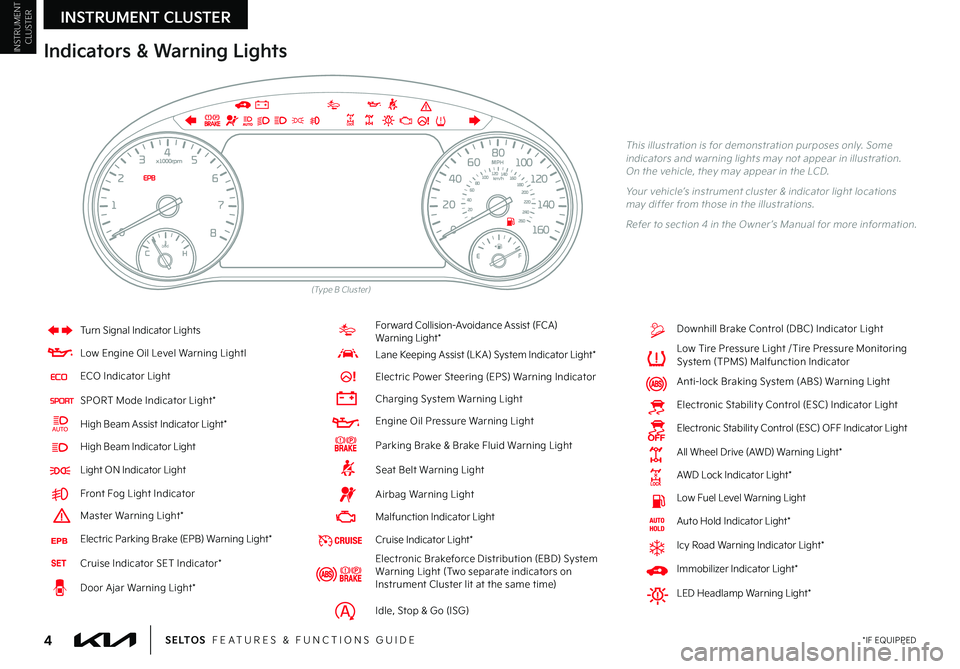
INSTRUMENT CLUSTER
INSTRUMENT CLUSTER
4 *IF EQUIPPEDS E LT O S FEATURES & FUNCTIONS GUIDE
(Type B Cluster)
Indicators & Warning Lights
This illustration is for demonstration purposes only . Some indicators and warning lights may not appear in illustration . On the vehicle, they may appear in the LCD .
Your vehicle’s instrument cluster & indicator light locations may differ from those in the illustrations .
Refer to section 4 in the Owner ’s Manual for more information .
Turn Signal Indicator Lights
Low Engine Oil Level Warning LightI
ECO Indicator Light
SPORT Mode Indicator Light*
High Beam Assist Indicator Light*
High Beam Indicator Light
Light ON Indicator Light
Front Fog Light Indicator
Master Warning Light*
Electric Parking Brake (EPB) Warning Light*
Cruise Indicator SET Indicator*
Door Ajar Warning Light*
For ward Collision-Avoidance Assist (FCA) Warning Light*
Lane Keeping Assist (LK A) System Indicator Light*
Electric Power Steering (EPS) Warning Indicator
Charging System Warning Light
Engine Oil Pressure Warning Light
Parking Brake & Brake Fluid Warning Light
Seat Belt Warning Light
Airbag Warning Light
Malfunction Indicator Light
Cruise Indicator Light*
Electronic Brakeforce Distribution (EBD) System Warning Light (Two separate indicators on Instrument Cluster lit at the same time)
Idle, Stop & Go (ISG)
Downhill Brake Control (DBC) Indicator Light
Low Tire Pressure Light / Tire Pressure Monitoring System (TPMS) Malfunction Indicator
Anti-lock Braking System (ABS) Warning Light
Electronic Stabilit y Control (ESC) Indicator Light
Electronic Stabilit y Control (ESC) OFF Indicator Light
All Wheel Drive (AWD) Warning Light*
AWD Lock Indicator Light*
Low Fuel Level Warning Light
Auto Hold Indicator Light*
Icy Road Warning Indicator Light*
Immobilizer Indicator Light*
LED Headlamp Warning Light*
Page 23 of 62

21
Rear Cross-Traffic Collision Avoidance Assist (RCCA)*†6
Rear Cross-Traffic Collision-Avoidance Assist (RCCA), under certain conditions, is designed to warn the driver and may activate the Electronic Stability Control (ESC) and temporarily apply braking if it detects cross traffic approaching the vehicle, when vehicle is in reverse .
When the RCCA rear-corner radar sensors detect approaching vehicles from the rear left or rear right side of the vehicle A, RCCA will sound a warning, the warning indicators on the outside rearview mirror will illuminate and a message will appear on the Instrument Cluster LCD B . If RCCA detects that the collision risk has increased, RCCA automatically applies the brakes to reduce your speed, potentially helping to minimize the effects of a possible collision .
RCCA is designed to operate under the following conditions:
•
When the gear shift is in Reverse
•When the vehicle is moving slower than 6 mph
RCCA User Settings:
•To go to the User Settings menu in the Instrument Cluster, press the Mode button C on the Steering Wheel when the vehicle is at a standstill, gear shift in Park and with the ignition on or the Engine Start/Stop button* in the ON position, and select User Settings
•
To turn RCCA on when in User Settings , press the Move (OK) button D up/down, select Driver Assistance, Parking Safety, Rear Cross-Traffic Safety and then press OK D
•
To set the initial warning timing, go to User Settings , press the Move (OK) button D up/down, then go to Driver Assistance, Warning Timing and press the OK button D
•
There are two settings:
– N o r m a l : Maximizes the amount of distance between the vehicles before the initial warning occurs
–
Later: Reduces the amount of distance between the vehicles before the initial warning occurs
•
Some models access settings through the Vehicle Settings in the audio head unit . Press the
Setup hard key on the audio head unit, then VEHICLE on the screen to enter Vehicle Settings
Refer to section 5 in the Owner ’s Manual for more information .
RES
SET
CNCL+
–
CRUISE
OK
RESSET
CNCL+
–
CRUISE
OKRESSET
CNCL+
–
CRUISE
OK
RESSET+
–
CRUISECRUISE CRUISE
OK
RES
SET+
–
CRUISE
OKRESSET+
–
CRUISE MODE
OK
RES
SET+
–OKRESSET+
–OK
MODE
(Type A; Controls located on right side of Steering Wheel)
Refer to the inside front cover for more information on QR codes .www .youtube .com/KiaFeatureVideos
Rear Cross-Traffic Collision Avoidance Assist (RCCA) Video
QR CODE
REMINDERS:
•
RCCA can be turned OFF/ON in User Set tings, under Driver Assistance, Parking Safet y
•
When vehicle power is cycled, RCCA will remain in the previous state
•
When a vehicle is approaching within the sensing range, and traveling faster than 3 mph, RCCA will show a warning
•
RCCA is a supplemental system . Do not solely rely on this system and always pay at tention to the road and its conditions
•
Prolonged use of the audio control unit in ACC mode may drain the vehicle’s bat ter y
RCCA Warning Volume* can be adjusted in the User Set tings in the Instrument Cluster or the Vehicle Set tings on the audio head unit . Go to Driver Assistance, then Warning Volume
QUICK TIP
C
D
A
†LEGAL DISCL AIMERS ON BACK INSIDE COVER | *IF EQUIPPEDALWAYS CHECK THE OWNER ’S MANUAL FOR COMPLETE OPER ATING INFORMATION AND SAFET Y WARNINGS .
ADVANCED DRIVER ASSISTANCE SYSTEMS (ADAS)
ADAS
B
Page 24 of 62

22†LEGAL DISCL AIMERS ON BACK INSIDE COVER | *IF EQUIPPEDS E LT O S FEATURES & FUNCTIONS GUIDE
Hill-Start Assist Control (HAC)†8
HAC is designed to help prevent the vehicle from rolling backward when accelerating from a stop while on a steep incline .
The HAC automatically activates whether the ESC is OFF or ON but does NOT activate when the ESC has malfunctioned .
OFF
(But tons located on left of Steering Wheel)
See section 5 in the Owner ’s Manual for more information .
See section 4 in the Owner ’s Manual for more information .
See section 5 in the Owner ’s Manual for more information .
DRIVER'S PANEL
DRIVER’SPANEL
Instrument Cluster Control
With parking lights/headlights ON, toggle switch A up (+) or down (-) to adjust the brightness of the instrument panel illumination .
Electronic Stability Control (ESC)†8
ESC is designed to help stabilize the vehicle during certain cornering maneuvers . It is a good idea to keep the ESC turned ON for daily driving whenever possible .
Press the ESC OFF button B to turn ESC OFF .
•When HAC is active (e .g ., during initial acceleration from a stop on an incline), you may notice that the brakes will momentarily remain engaged after you depress the accelerator – this is normal operation
•HAC provides a t wo-second delay before the vehicle may star t rolling backward
QUICK TIPS
REMINDERS:
•
The HAC does not operate when the gear shift is in the P (Park) or the N (Neutral) position
•
HAC does not replace the need to apply brakes while the vehicle is stopped on an incline
•In the event of HAC system malfunction, see an Authorized Kia Dealer for ser vice
REMINDERS:
•
ESC is turned ON by default at vehicle star tup . When ignition is cycled, ESC will turn ON again
•
The ESC Indicator Light in the instrument cluster will illuminate whenever the ESC is in operation
A
B
Page 28 of 62

26 *IF EQUIPPEDS E LT O S FEATURES & FUNCTIONS GUIDE
STEERING WHEEL CONTROLS
STEERING WHEEL CON
-
TROLS
High Beam Assist (HBA)
High Beam Assist is designed to automatically adjust the headlight range by switching between high and low beams based on light detected from other vehicles and road conditions .
To enable HBA , toggle the light switch to the AUTO Light position and turn on the high beams by pushing the lever away from you . The High Beam Assist indicator will illuminate .Headlight ON position
Parking light position
AUTOAuto Light* / DRL / HBA
OFFLights OFF
AUTO
OF F
OFF
�"
High Beam Assist does not operate below cer tain speeds, or in some lighting and driving conditions . Please be aware of your surroundings and exercise proper road etiquet te when operating a vehicle using the high beams .
One-Touch Lane Change Signal
Refer to section 4 in the Owner ’s Manual for more information .
Refer to section 4 in the Owner ’s Manual for more information .
Headlights & High Beams
To operate:
•Rotate lever switch to change the Headlight function
•Push lever to turn High Beams ON
•Pull lever to flash Headlights / High Beams
AUTO Light* – When the light switch is in the AUTO Light position, the tail lights and headlights will turn ON/OFF automatically, depending on the amount of light outside the vehicle .Turn Signals & Fog Lights*
To operate:
•Turn Signals - Move lever Up/Down for Right/Left Turn Signal
•Fog Lights - Press switch A up/down to turn Fog Lights ON/OFF
One-Touch Lane Change Signal is activated by briefly pressing the Turn Signal Lever up/down slightly for less than 1 second and then releasing . The lane change signal will blink 3 times .
To change how many times (3/5/7) the Lane Change Signal blinks, go to User Settings Mode* in the LCD Instrument Cluster modes .
See section 4 in the Owner ’s Manual for more information .
Daytime Running Lights (DRL)*
DRL may help others to see the front of your vehicle during the day . The lights will be on automatically when the ignition or
Engine Start/Stop button is ON and the headlight switch is in the AUTO position, unless one of the following occurs:
•Headlights are on
•Parking brake is applied
•Fog lights are on
•Engine is turned off
•Switch is in the OFF position
REMINDERS:
•
HBA will operate when vehicle speed exceeds 25 mph
•
If the lever is pushed away from you while HBA is operational, HBA will turn off and the high beams will be on continuously . If the lever is pulled toward you while HBA is operational, HBA will turn off
•
If the light switch is switched to the headlight position, HBA will turn off and the low beams will be on continuously
A
REMINDER: DRL only operates during the day time
REMINDER: Headlights must be ON for fog light operation .
Page 43 of 62
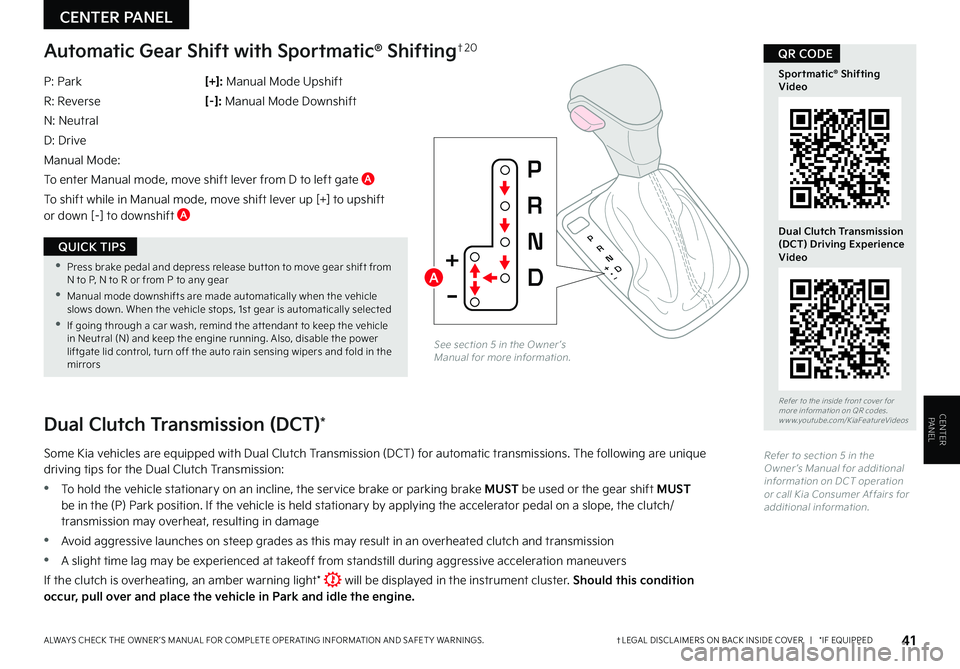
CENTER PANEL
CENTER PANEL
41†LEGAL DISCL AIMERS ON BACK INSIDE COVER | *IF EQUIPPEDALWAYS CHECK THE OWNER ’S MANUAL FOR COMPLETE OPER ATING INFORMATION AND SAFET Y WARNINGS .
P
R
N
D
+
•
-
Automatic Gear Shift with Sportmatic® Shifting†2 0
P: Park
R: Reverse
N: Neutral
D: Drive
Manual Mode:
To enter Manual mode, move shift lever from D to left gate A
To shift while in Manual mode, move shift lever up [+] to upshift or down [–] to downshift A
[+]: Manual Mode Upshift
[–] : Manual Mode Downshift
See section 5 in the Owner ’s Manual for more information .
Dual Clutch Transmission (DCT)*
Some Kia vehicles are equipped with Dual Clutch Transmission (DCT) for automatic transmissions . The following are unique driving tips for the Dual Clutch Transmission:
•To hold the vehicle stationary on an incline, the service brake or parking brake MUST be used or the gear shift MUST be in the (P) Park position . If the vehicle is held stationary by applying the accelerator pedal on a slope, the clutch/transmission may overheat, resulting in damage
•Avoid aggressive launches on steep grades as this may result in an overheated clutch and transmission
•A slight time lag may be experienced at takeoff from standstill during aggressive acceleration maneuvers
If the clutch is overheating, an amber warning light* will be displayed in the instrument cluster . Should this condition occur, pull over and place the vehicle in Park and idle the engine.
Refer to section 5 in the Owner ’s Manual for additional information on DCT operation or call Kia Consumer Affairs for additional information .
Refer to the inside front cover for more information on QR codes .www .youtube .com/KiaFeatureVideos
Sportmatic® Shifting Video
Dual Clutch Transmission (DCT) Driving Experience Video
QR CODE
A •Press brake pedal and depress release but ton to move gear shift from N to P, N to R or from P to any gear
•Manual mode downshifts are made automatically when the vehicle slows down . When the vehicle stops, 1st gear is automatically selected
•If going through a car wash, remind the at tendant to keep the vehicle in Neutral (N) and keep the engine running . Also, disable the power liftgate lid control, turn off the auto rain sensing wipers and fold in the mirrors
QUICK TIPS
Page 44 of 62

CENTER PANEL
CENTER PANEL
42 *IF EQUIPPEDS E LT O S FEATURES & FUNCTIONS GUIDE
•When leaving your keys with parking lot at tendants or valet, make sure to inform them how to operate the EPB
•Pull up and hold EPB switch a second time to increase brake pressure if parked on a decline or incline
•If parked on a steep incline, pull up the EPB switch for more than 3 seconds for a firmer EPB application
QUICK TIPS
REMINDERS:
•
As a bulb check, the EPB malfunction indicator will illuminate for approximately 3 seconds when the ignition switch is turned ON
•
If the warning light does not illuminate temporarily, or continues to remain lit, take your vehicle to an authorized Kia dealer and have the system checked
•The EPB should not be operated while the vehicle is moving
•
A click or electric brake motor sound may be heard while operating or releasing the EPB, but these conditions are normal and indicate that the EPB is functioning properly
The Electronic Parking Brake (EPB) system utilizes an electric motor to engage the parking brake .
Applying the Parking Brake
Depress the brake pedal and pull up the EPB switch A . Ensure that the indicator light is illuminated on the instrument cluster .
If parked on a steep incline/decline, pull up the EPB switch for more than 3 seconds for a firmer EPB application .
Releasing the Parking Brake
The EPB will automatically release when the shifter is placed in Reverse or Drive . To release EPB manually, depress the brake
pedal, then press the EPB switch A, with the ignition switch in the ON position . Ensure that the indicator light is OFF .
(Type B shown . Located below gear shift)
Electronic Parking Brake (EPB)*
AUTO
HOLD
Auto Hold*
See section 5 in the Owner ’s Manual for more information .
Auto Hold temporarily maintains the vehicle at a standstill even though the brake pedal is not depressed after the driver brings the vehicle to a complete stop by depressing the brake pedal . Auto Hold can be turned On/Off using the AUTO HOLD button B on the center panel below the gear shift . Before Auto Hold will operate, the driver ’s door, engine hood and liftgate must be closed, and the driver ’s seat belt must be fastened .
The Auto Hold indicator on the Instrument Cluster has four states:
White: Standby – With vehicle at a standstill and AUTO HOLD button B pressed On, the indicator will illuminate
white . While driving the vehicle (vehicle is not at a standstill), the Auto Hold indicator will remain white .
Green: Engaged – When coming to a complete stop by depressing the brake pedal, the Auto Hold indicator changes from white to green .
Off (not illuminated) – The indicator will turn off when the AUTO HOLD button B is manually pressed off or when the EPB is manually turned on .
Yellow: Malfunction - When the indicator is illuminated yellow, there may be a system malfunction . Take your vehicle to a local Kia dealer .
REMINDERS:
•
Auto Hold only operates when vehicle is in Drive or Neutral
•
To reduce the risk of an accident, do not activate Auto Hold while driving downhill, backing up or parking your vehicle
•
Do not solely rely on the Auto Hold system to keep the vehicle stopped . Always pay at tention to traf fic and road conditions, and be prepared to depress the brakes
Refer to page 4 for location of Instrument Cluster indicators .
See section 5 in the Owner ’s Manual for more information .
Refer to the inside front cover for more information on QR codes .www .youtube .com/KiaFeatureVideos
Electric Parking Brake Video
QR CODE
AB
Page 52 of 62
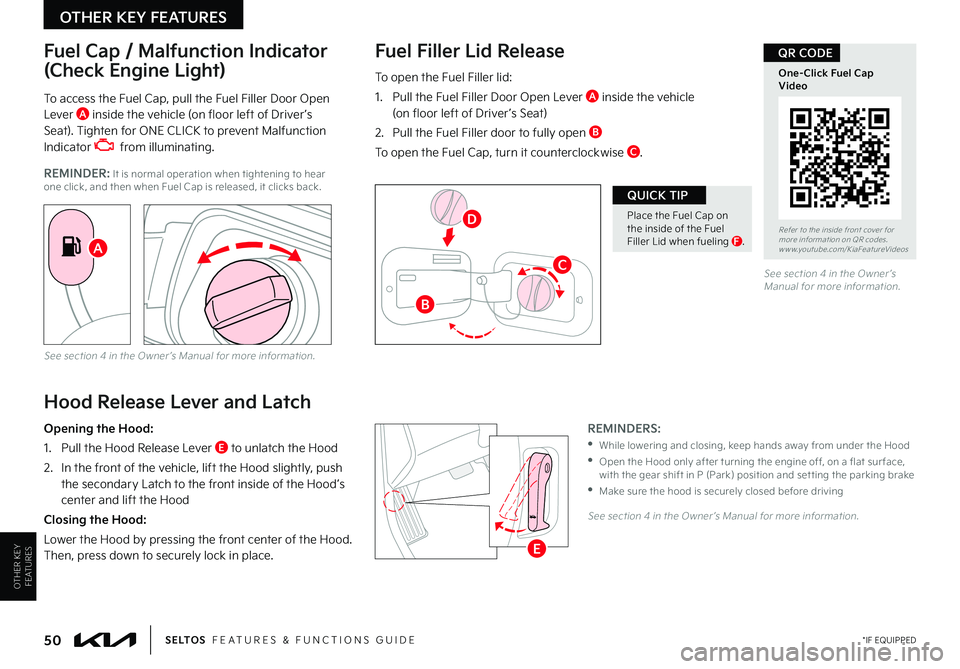
50 *IF EQUIPPEDS E LT O S FEATURES & FUNCTIONS GUIDE
Place the Fuel Cap on the inside of the Fuel Filler Lid when fueling F .
QUICK TIP
REMINDERS:
•
While lowering and closing, keep hands away from under the Hood
•
Open the Hood only after turning the engine off, on a flat sur face, with the gear shift in P (Park) position and set ting the parking brake
•Make sure the hood is securely closed before driving
Fuel Filler Lid ReleaseFuel Cap / Malfunction Indicator
(Check Engine Light)To open the Fuel Filler lid:
1 . Pull the Fuel Filler Door Open Lever A inside the vehicle (on floor left of Driver ’s Seat)
2 . Pull the Fuel Filler door to fully open B
To open the Fuel Cap, turn it counterclockwise C .
To access the Fuel Cap, pull the Fuel Filler Door Open Lever A inside the vehicle (on floor left of Driver ’s Seat) . Tighten for ONE CLICK to prevent Malfunction Indicator from illuminating .
See section 4 in the Owner ’s Manual for more information .
See section 4 in the Owner ’s Manual for more information .
See section 4 in the Owner ’s Manual for more information .
OTHER KEY FEATURES
OTHER KEY FEATURES
Refer to the inside front cover for more information on QR codes .www .youtube .com/KiaFeatureVideos
One-Click Fuel Cap Video
QR CODE
Hood Release Lever and Latch
Opening the Hood:
1 . Pull the Hood Release Lever E to unlatch the Hood
2 . In the front of the vehicle, lift the Hood slightly, push the secondary Latch to the front inside of the Hood’s center and lift the Hood
Closing the Hood:
Lower the Hood by pressing the front center of the Hood . Then, press down to securely lock in place .
A
REMINDER: It is normal operation when tightening to hear one click, and then when Fuel Cap is released, it clicks back .
E
B
C
D
Page 58 of 62
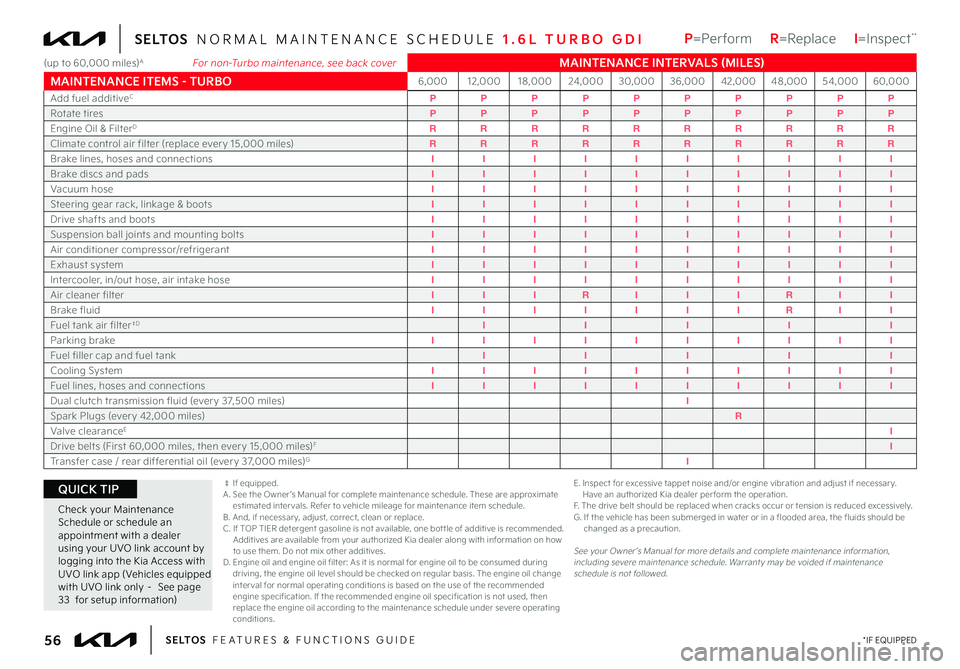
Check your Maintenance Schedule or schedule an appointment with a dealer using your UVO link account by logging into the Kia Access with UVO link app (Vehicles equipped with UVO link only – See page 33 for setup information)
QUICK TIP
56 *IF EQUIPPEDS E LT O S FEATURES & FUNCTIONS GUIDE
‡ If equipped .A . See the Owner ’s Manual for complete maintenance schedule . These are approximate estimated inter vals . Refer to vehicle mileage for maintenance item schedule . B . And, if necessar y, adjust, correct, clean or replace .C . If TOP TIER detergent gasoline is not available, one bot tle of additive is recommended . Additives are available from your authorized Kia dealer along with information on how to use them . Do not mix other additives .D . Engine oil and engine oil filter: As it is normal for engine oil to be consumed during driving, the engine oil level should be checked on regular basis . The engine oil change inter val for normal operating conditions is based on the use of the recommended engine specification . If the recommended engine oil specification is not used, then replace the engine oil according to the maintenance schedule under severe operating conditions .
E .
Inspect for excessive tappet noise and/or engine vibration and adjust if necessar y . Have an authorized Kia dealer per form the operation .F . The drive belt should be replaced when cracks occur or tension is reduced excessively .G . If the vehicle has been submerged in water or in a flooded area, the fluids should be changed as a precaution .
See your Owner ’s Manual for more details and complete maintenance information, including severe maintenance schedule . Warrant y may be voided if maintenance schedule is not followed .
P=Per form R=Replace I=Inspect**S E LT O S NORMAL MAINTENANCE SCHEDULE 1.6L TURBO GDI
(up to 60,000 miles)A For non-Turbo maintenance, see back coverMAINTENANCE INTERVALS (MILES)
MAINTENANCE ITEMS - TURBO6,00012,00018,00024,00030,00036,00042,00048,00054,00060,000
Add fuel additiveCPPPPPPPPPPRotate tiresPPPPPPPPPPEngine Oil & FilterDRRRRRRRRRRClimate control air filter (replace ever y 15,000 miles)RRRRRRRRRRBrake lines, hoses and connectionsIIIIIIIIIIBrake discs and padsIIIIIIIIIIVacuum hoseIIIIIIIIIISteering gear rack, linkage & bootsIIIIIIIIIIDrive shafts and bootsIIIIIIIIIISuspension ball joints and mounting boltsIIIIIIIIIIAir conditioner compressor/refrigerantIIIIIIIIIIExhaust systemIIIIIIIIIIIntercooler, in/out hose, air intake hoseIIIIIIIIIIAir cleaner filterIIIRIIIRIIBrake fluidIIIIIIIRIIFuel tank air filter‡DIIIIIParking brakeIIIIIIIIIIFuel filler cap and fuel tankIIIIICooling SystemIIIIIIIIIIFuel lines, hoses and connectionsIIIIIIIIIIDual clutch transmission fluid (ever y 37,500 miles)ISpark Plugs (ever y 42,000 miles)RValve clearanceEIDrive belts (First 60,000 miles, then ever y 15,000 miles)FITransfer case / rear differential oil (ever y 37,000 miles)GI
Page 62 of 62
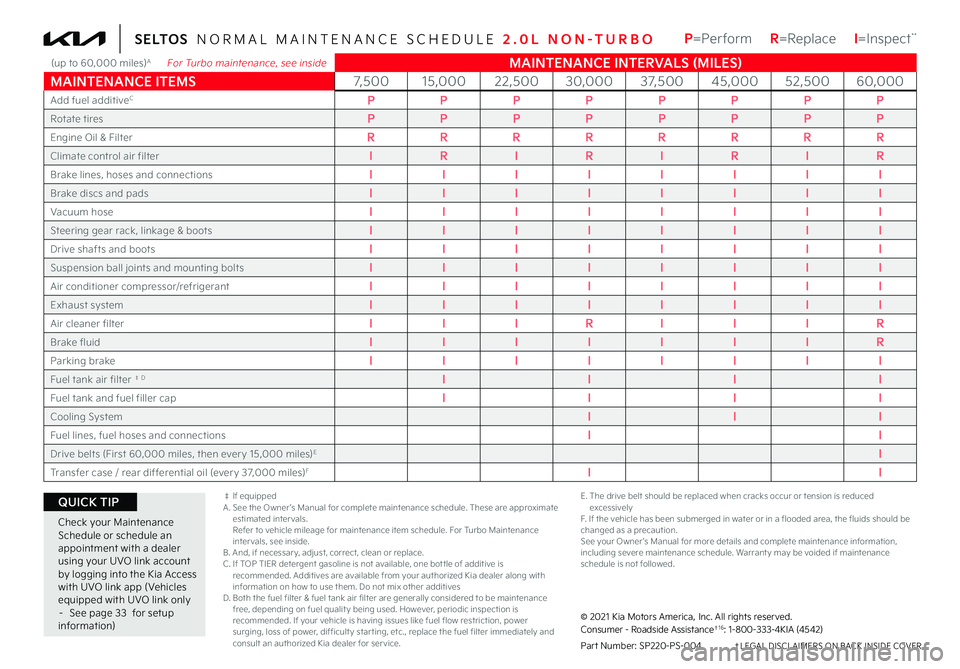
*IF EQUIPPED
P=Per form R=Replace I=Inspect**S E LT O S NORMAL MAINTENANCE SCHEDULE 2.0L NON-TURBO
‡ If equippedA . See the Owner ’s Manual for complete maintenance schedule. These are approximate estimated intervals. Refer to vehicle mileage for maintenance item schedule. For Turbo Maintenance inter vals, see inside.B. And, if necessar y, adjust, correct, clean or replace.C . If TOP TIER detergent gasoline is not available, one bot tle of additive is recommended. Additives are available from your authorized Kia dealer along with information on how to use them. Do not mix other additivesD. Both the fuel filter & fuel tank air filter are generally considered to be maintenance free, depending on fuel qualit y being used. However, periodic inspection is recommended. If your vehicle is having issues like fuel flow restriction, power surging, loss of power, difficult y star ting, etc., replace the fuel filter immediately and consult an authorized Kia dealer for ser vice.
E. The drive belt should be replaced when cracks occur or tension is reduced excessivelyF. If the vehicle has been submerged in water or in a flooded area, the fluids should be changed as a precaution.See your Owner ’s Manual for more details and complete maintenance information, including severe maintenance schedule. Warrant y may be voided if maintenance schedule is not followed.
Check your Maintenance Schedule or schedule an appointment with a dealer using your UVO link account by logging into the Kia Access with UVO link app (Vehicles equipped with UVO link only – See page 33 for setup information)
QUICK TIP
© 2021 Kia Motors America, Inc. All rights reserved.Consumer - Roadside Assistance†16: 1-800-333-4KIA (4542)
Part Number: SP220-PS-004 †LEGAL DISCL AIMERS ON BACK INSIDE COVER
(up to 60,000 miles)A For Turbo maintenance, see insideMAINTENANCE INTERVALS (MILES)
MAINTENANCE ITEMS7, 5 0 015,00022,50030,0003 7, 5 0 045,00052,50060,000
Add fuel additiveCPPPPPPPP
Rotate tiresPPPPPPPP
Engine Oil & FilterRRRRRRRR
Climate control air filterIRIRIRIR
Brake lines, hoses and connectionsIIIIIIII
Brake discs and padsIIIIIIII
Vacuum hoseIIIIIIII
Steering gear rack, linkage & bootsIIIIIIII
Drive shafts and bootsIIIIIIII
Suspension ball joints and mounting boltsIIIIIIII
Air conditioner compressor/refrigerantIIIIIIII
Exhaust systemIIIIIIII
Air cleaner filterIIIRIIIR
Brake fluidIIIIIIIR
Parking brakeIIIIIIII
Fuel tank air filter ‡ DIIII
Fuel tank and fuel filler capIIII
Cooling SystemIII
Fuel lines, fuel hoses and connectionsII
Drive belts (First 60,000 miles, then ever y 15,000 miles)EI
Transfer case / rear differential oil (ever y 37,000 miles)FII